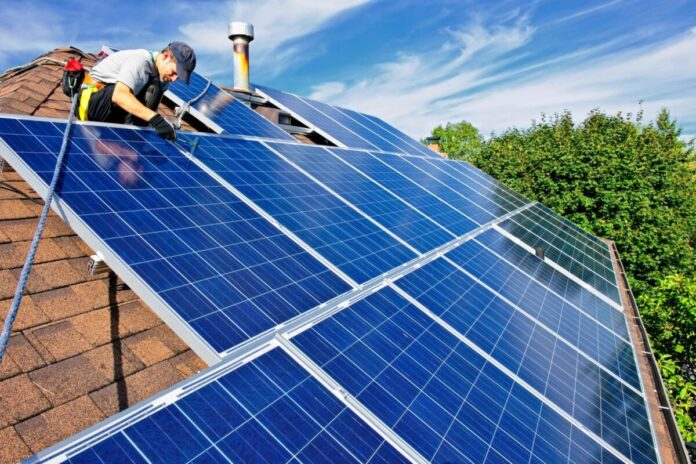I met with a solar power installer the other day. I did some research on the company beforehand, and it checked several boxes. The owner has a contractor’s license and is bonded and insured. He is a member of a couple of professional organizations, and the company is an authorized dealer for several brands or solar equipment.
When I met him, I felt comfortable, in part because we knew some people in common. It didn’t hurt that he has worked in the area for years and lives off-grid. He also was knowledgeable and offered plenty of advice.
Hybrid or Grid Tied
As you might recall from my prior posts, I was initially looking into a hybrid system that would sell excess electricity back to the utility. As I did more research, I began to lean away from this option because I had come across complaints that it rarely saved you as much on your electric bill as the installers promised and that there were insurance concerns. Not only could the utility require us to have $1 million in liability insurance, our insurance carrier might balk at covering us, or at least parts of the solar system.
The installer said no one should let the lure of a low electric bill convince them to spend tens of thousands on a hybrid solar system. However, if we were already planning to install a solar system, it cost so little to upgrade it to hybrid or grid tied inverter that it would be stupid not to. He also said the process and the benefit vary from utility to utility and state to state.
Moral of the story: Don’t fall for those salespeople who promise you no electric bill and offer financing deals (often with no batteries), but if you want solar, being able to sell power back to the electric utility might benefit you.
I came away convinced. I am back in favor of a hybrid system, but I’m not expecting it to reduce my electricity bill to zero, or anywhere close to zero.
How Much Power do I Need?
When you evaluate solar systems, there are several numbers you need to consider:
- How much power your panels can produce in optimal conditions, and how much they are likely to produce over the course of your average day
- How much power your inverter can send to your battery, to your house, and out to the grid at the same time
- How much power your batteries can store
- How long that store power will last you
Obviously, the three components work together, so you need to size them accordingly. You also have to size them to your electrical demands. You don’t want to install a system that gets overloaded and shuts down if someone turns on the bathroom fan while the microwave is on.
Much to my surprise, the installer recommended a system smaller than I had been looking into. Meaning fewer panels producing less power with a smaller inverter. We were on the same page with battery storage, however.
Inline with this, he suggested a system that provided backup for only a portion of the house, not the whole house. So similar to a whole-house generator, we would have a separate breaker box with critical circuits that the solar system powers when grid power goes down. Circuits that would not have power during a grid-down scenario would include the dryer, the oven, the hot water heater, and the heat pump.
I expect he made this recommendation for cost reasons. I don’t know if he looked at me and our house and decided that as big a system as we could afford, or if he knows it is better to start with a low bid and then add on to it if we want more capabilities. Because I have not yet received his proposal, I don’t know what his numbers will be.
The Hot Water Conundrum
My wife is willing to live without air conditioning because we only use it a few days a year. We also heat with firewood, so we don’t use the heat pump in the winter. However, she is not happy about missing out on hot water. Besides showers, we use hot water when we run the laundry, the dishwasher, or do the dishes by hand.
The challenge is a hot water tank uses about 4500 watts every time it kicks in. If it runs three hours over the course of a day, that’s 13.5 kWh of electricity, meaning the electric hot water heater is responsible for about half of the electricity our household consumes. That’s more than our panels will produce in a single hour. It represents a significant chunk of our solar power consumption and an even larger chunk of our battery storage capacity. You can see why the installer didn’t want to cover the hot water heater.
During a short-term power outage, this is not a big issue. If it is a multi-day outage, we’re stuck with too little power for hot water.
So, some kind of compromise is needed. Options are:
- Install a propane hot water heater. This one won’t work because we have no propane on the premises.
- Install an electric on-demand hot water heater. We may consider this if our current hot water heater goes bad. They can reduce the electricity needed to heat hot water by up to 30 percent.
- Install a heat pump hot water heater. These are up to 75 percent more efficient and I’ve seen models that supposedly use less than 2.4 kWh per day. But how well will the heat pump work in our cold winters?
- Use our current hot water heater only when the sun shines.
Using Power when the Sun Shines
Let’s talk about the last bullet. Because the sun doesn’t shine 24-hours a day, the panels produce more power in full sunlight that we normally consume at one time. When the grid is operating, our proposed system will send power from the solar panels to the battery to recharge it. Any extra power then goes to power the house. When we are not consuming as much electricity as the panels are producing, the leftover power goes to the grid. But what happens to the extra power when the grid is down? The electricity goes to waste.
During a long-term grid scenario—call it a survival situation—we would want our system to recharge the batteries and then power the house. Once it charges the batteries, we can power “extra” systems, like the hot water heater. So when the sun is shining and the batteries are full, we turn on the hot water heater. If it is our current tank model, it could take an hour to fully heat up. If we have a new hot tankless model, we could start using the hot water right away. One advantage of our current hot water heater is that the water will remain hot for a while, even after we turn its circuit breaker back off.
Once the tank warms up, we use the surplus electricity to run the washer (less than 1,000 watts) or do a load of dishes in the dishwasher (1.5 kWh). Like the hot water heater, an electric clothes dryer can use several kWh or electricity at a time. We probably would not want to run it and the hot water heater at the same time. This is why I have clothesline and clothespins stored away.
We are Spoiled
The idea that an almost unlimited supply of electricity is available at the click or a switch or the turn of a knob has spoiled us. It makes our lives easy, convenient, and allows us to work less than our forefathers. It enables us, helps us communicate and stay entertained, and allows us to work when it is dark out. When electricity becomes limited, people get upset, and if it disappears, they will miss it.
In a grid-down scenario, when the vast majority of the country is without power, I bet my wife will be happy to have hot water for a few hours on a sunny day. I expect she’ll be willing to hang things on the clothesline to dry after using the washer instead of scrubbing them by hand in a bucket. I hope she’ll delight in using the microwave instead of heating something on the wood stove. And we’ll all be happy to have lights.
There are only three fixtures in our house that don’t have LED lights, and they all use a specialty bulb of some sort. On average, these LED bulbs use just 22 percent of the power incandescent bulbs require to produce the same amount of light. That means a solar system can provide four times as much light today as the same size system did ten years ago. In fact, when calculating our load, the installer didn’t even address lights. Of course, that doesn’t mean we’ll want to leave lights on in an empty room, but we’re pretty good about that already.
Tax Credits for Solar
The U.S. government offers a tax credit for 30 percent of the system value. That’s a nice benefit. The problem is that if you don’t use the entire credit in the year you earn it, it goes away. So if we only owe $5,000 in taxes and we earn $6,000 or more tax credits, anything above the $5,000 level goes to waste.
That is leading me to think I should buy the panels, inverter, and one battery bank this year and then buy and install two more battery banks next year. That would allow me to spread the tax credit out over two years and benefit from every bit of it. It will also allow me to spread the cost out over two years, which will be easier on our budget.
Update as of 1/18/24: Since posting the above, I have been told that the solar tax credits DO carryover from year to year. I subsequently confirmed this with my accountant. Apologies for the incorrect data and thanks to those who pointed out this error.
A Good Start
While I consider this meeting to have been a good start, I’m still waiting for the proposal and the budget estimate. There’s a cost for using experienced vendors, of course, but without knowing what that is, I can’t tell if it’s worth it. I know he doesn’t want to use the EG4 equipment I’ve gotten quotes on, saying it doesn’t have a track record. But I’ve watched videos on the inverter he recommends, and several people have experienced problems with it. So we’ll have to see. In any case, I’ll have some data and I can determine how to proceed from that point.







